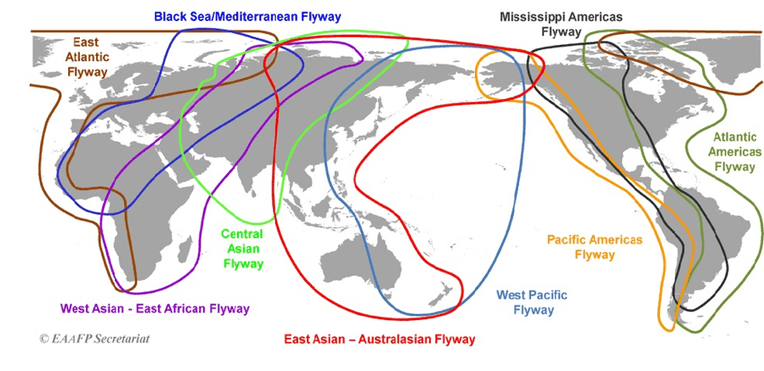Flyways
From the Series: Speaking Volumes
From the Series: Speaking Volumes

In August 2013, a headline from the Associated Press read “Egyptian authorities detain suspected ‘spy’ bird,” accompanied by a photograph of a forlorn-looking stork standing behind iron bars. This was not the first or last time that authorities had captured a migratory bird—with bands on its legs, marks on its feathers, or satellite trackers strapped to its body—and held it on allegations of espionage. Especially during the Cold War, birds’ ability to cross national boundaries and connect people separated by geopolitical and ideological enmity could provoke concerns over national security. In the last Cold War borderland separating North Korea from South Korea, though, migratory birds are less likely to be arraigned on charges of espionage than to be enrolled as portents of peace, particularly in recent South Korean narratives that extol nature’s ability to heal the scars of war and transcend political division.
The reason birds can be mistaken for tools of spycraft or elevated to symbolic envoys is because they themselves are highly surveilled by conservationists and bird watchers. Human knowledge of bird migration depends on techniques as old as banding and as contemporary as remote sensing. Given the long history of humans watching, tracking, documenting, and attempting to prey on or protect birds, avian flyways are both ethological representations of bird behavior as well as a kind of technobiopolitics that Donna Haraway (2008, 261) calls “fugal accompaniment.” Thus, while narratives of birds as spies or envoys are certainly anthropocentric, this does not mean one should seek out more authentic, avian-centered representations. Particularly in the context of climate change, global capitalism, and rampant militarization, hardly any creature could be purified from its entanglement in human–nonhuman ecologies and politics.
For instance, South Koreans have frequently celebrated the charismatic and highly endangered cranes that winter in the Korean peninsula as messengers of peace. A more accurate anthropomorphic metaphor would be that of refugees, however, as it was the famine conditions in North Korea in the late 1990s that drove the mass arrival of wintering cranes to the southern side of the DMZ. What is known in the Koreas as the Arduous March led to hundreds of thousands, if not millions, of human fatalities, and also to the decline in populations of endangered migratory birds like the black-faced spoonbill (jeoeosae), red-crowned crane (durumi), and white-naped crane (jae durumi). Crane diets have coevolved with humans and much of their winter feed consists of gleanings from the autumn rice harvest. With the collapse of the food system in North Korea, hundreds of these cranes, as well as cinereous vultures (doksuri), descended in unprecedented numbers in the northern areas of South Korea. This migratory adaptation to food scarcity in the North, though, in turn exposed the cranes to degraded ecological conditions in the South, where development of the western coast and industrialized agricultural practices had deleterious effects on these birds’ survival. Populations of black-faced spoonbill that breed on the western coast of the peninsula likewise declined in this period, perhaps from starving North Koreans stealing eggs from their nests. Now, ongoing destruction of wetlands and tidal flats on the west coast due to land reclamation projects has exiled this formerly frequent visitor to remote uninhabited islets in the Yellow Sea.
The seasonal migrations of cranes, spoonbills, and vultures are part of the larger East Asian Australasian Flyway, the largest of the world’s nine designated flyways. The flyway concept is a conservation framework that is impressively capacious in its scaling from individual birds within a given population to groups of birds within or across species (including their unpredictable variations) to transnational human activities that respond to the needs of bird survival. Local and international nongovernmental and governmental activities traverse the national borders that birds cross and engage with states that regulate the environments on which birds depend. Flyways are infrastructural in that birds use them to migrate across distances, but flyways are also a functional abstraction that scientists use to coordinate across national borders and to craft international and global conservation strategies.
The flyway concept is holistic and functionalist in its aspirations to capture the “totality of the ecological systems that are necessary to enable a migratory [bird] to survive and fulfill its annual cycle” (Boere and Stroud 2006, 45). We can think of the flyway as mediated and multiple: it is continually emergent from the patterned activities of breeding, feeding, and migrating, which are themselves inextricable from the knowledge techniques that humans use to document and interpret these activities. Flyways may describe the migratory patterns of birds, but they are also constituted from the phatic labor (see Elyachar 2010) and intersubjective imaginaries of humans who maintain channels for the exchange of knowledge and who are affected by birds across their distant habitats. Birds’ abilities to create transnational connections depend upon human networks of care across national boundaries and sovereign territories. Their worldliness is what makes them vulnerable in multiple locales and what generates the networked cosmopolitanism of the humans who love them.

A map of avian flyways presents a defamiliarizing cartography that can disorient our human-centered sense of planetary space. Yet it is a crude diagrammatic reduction of evolutionary and idiosyncratic relations that are multispecies, multiscalar, and historically tied to national and international conservation efforts. Conservationists consider birds ideal indicator species, using their presence or absence to infer the sustainability of an ecosystem. The population decline of more than half of the world’s migratory bird species due to the reduction of their seasonal habitats (see Runge et al. 2015) is thus a worrisome indicator of ecological degradation and biodiversity loss at a planetary scale. Rather than decentering human views of planetary space, therefore, flyways are, more accurately, our very own cartographies of the Anthropocene.
Boere, Gerard C., and David A. Stroud. 2006. “The Flyway Concept: What It Is and What It Isn’t.” In Waterbirds around the World: A Global Overview of the Conservation, Management, and Research of the World’s Waterbird Flyways, edited by G. C. Boere, C. A. Galbraith, and D. A. Stroud, 40–47. Edinburgh, UK: Stationery Office.
Elyachar, Julia. 2010. “Phatic Labor, Infrastructure, and the Question of Empowerment in Cairo.” American Ethnologist 37, no. 3: 452–64.
Haraway, Donna J. 2008. When Species Meet. Minneapolis: University of Minnesota Press.
Runge, Claire A., James E. M. Watson, Stuart H. M. Butchart, Jeffrey O. Hanson, Hugh P. Possingham, and Richard A. Fuller. 2015. “Protected Areas and Global Conservation of Migratory Birds.” Science 350, no. 6265: 1255–58.